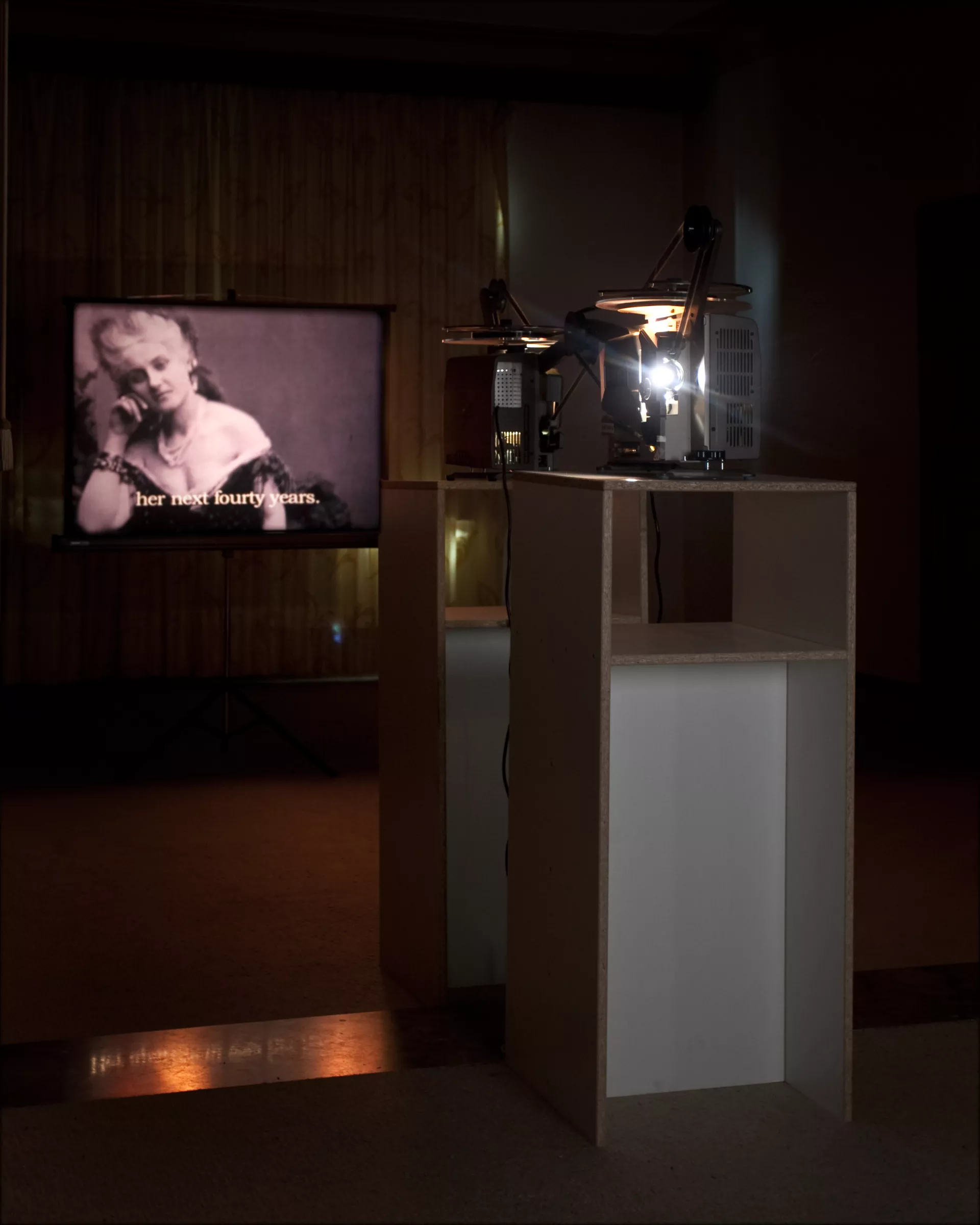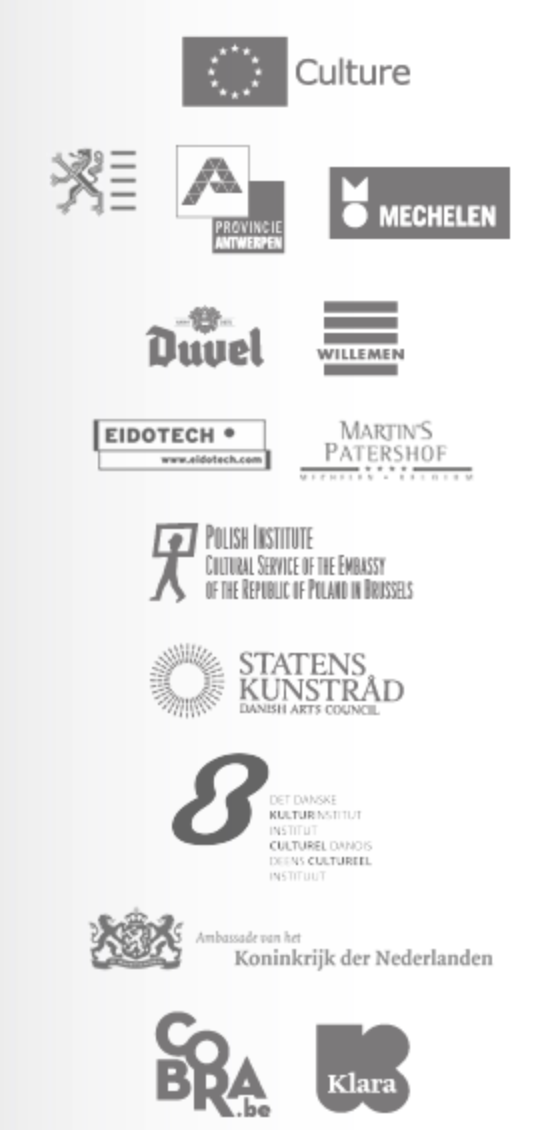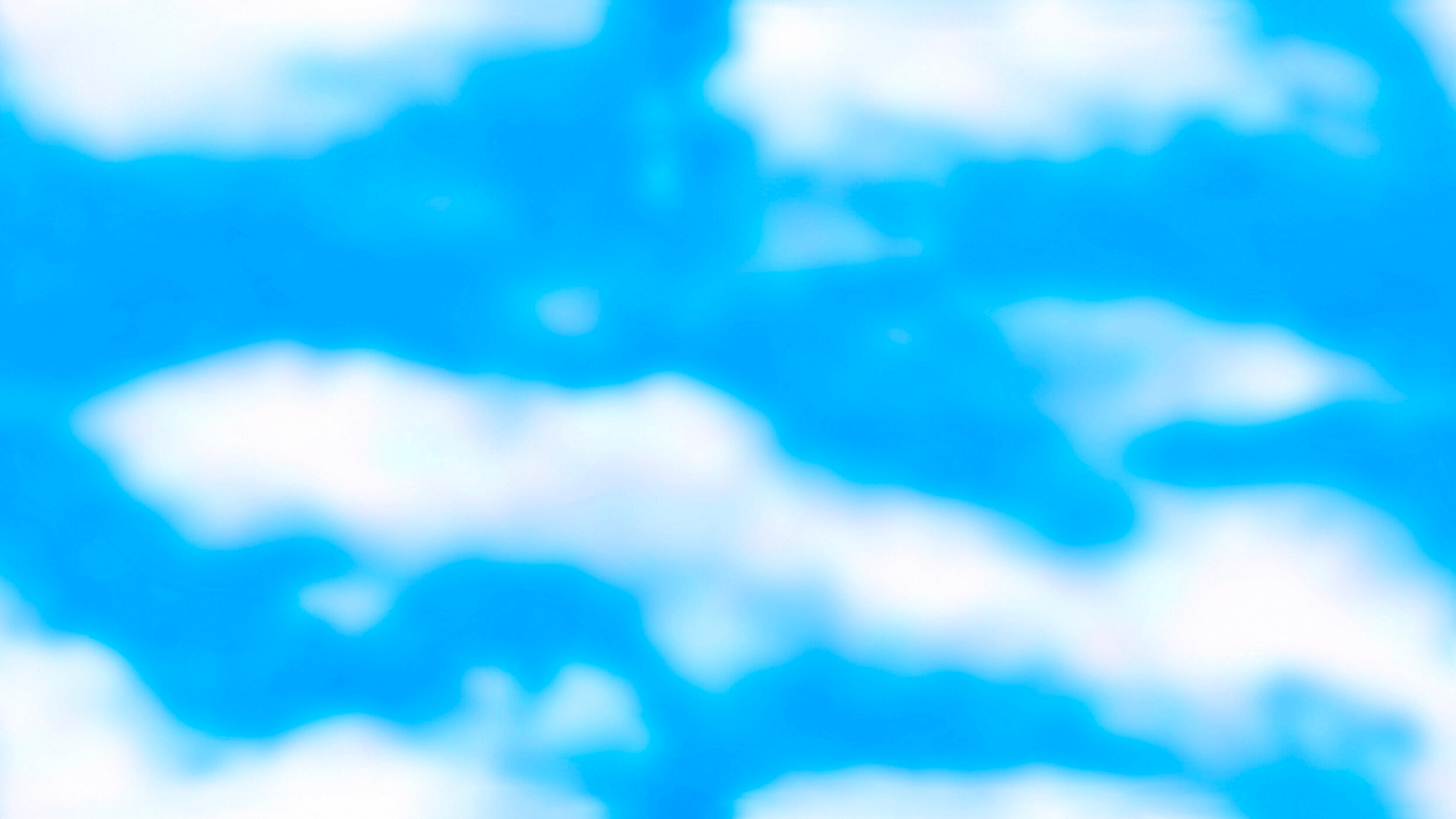Contour 2009
HIDDEN IN REMEMBRANCE IS THE SILENT MEMORY OF OUR FUTURE
The exhibition “Hidden in Remembrance is the Silent Memory of our Future” explores how history shapes our perception of the present and future. Taking place twenty years after a pivotal historical moment, the biennial reflects on historical representation and the re-evaluation of narratives in contemporary art. The artists, using various narrative strategies, engage with memory, time, and history's influence on societal and cultural being. The exhibition emphasizes complex, layered, and cinematic works, urging viewers to engage deeply with history and the passage of time. It also features newly commissioned work and invites reflection on whose history is told.
Curated by Katerina Gregos
Graphic designer Sfumato
Exhibition architects Lhoas & Lhoas
Artists: Eija-Liisa Ahtila, Herman Asselberghs, Yael Bartana, Ulla von Brandenburg, Andreas Bunte, Lene Berg, Michaël Borremans, Matthew Buckingham, Chto Delat, Maryam Jafri, David Maljkovic, Vincent Meessen, Nathaniel Mellors, Wendelien van Oldenborgh, Julian Rosefeldt, Mira Sanders, Yorgos Sapountzis, T.J. Wilcox

LOCATIES
CULTURAL CENTER MECHELEN
Mary Koszmary (Dreams and Nightmares, 2007) addresses anti-Semitism and xenophobia, reflecting on the legacy of the Holocaust. Set in a dilapidated Warsaw stadium, the film features Polish intellectual Sławomier Sierakowsky, who passionately calls for the return of the lost Jewish community to Poland. Using propaganda aesthetics, Yael Bartana’s work advocates for tolerance and examines historical ghosts from one of the darkest moments of the 20th century. Bartana’s art often explores Israel's social-political conflicts, and her work has been featured in major international museums and Documenta 2007.
Where is Where? (2007/2008) by Eija-Liisa Ahtila explores colonialism and cultural tensions, focusing on a real event in 1950s Algeria. After the French occupation, two Algerian boys kill their French friend in response to atrocities. Decades later, a poetess becomes obsessed with this crime, reflecting on colonialism's lasting impact and the trauma it caused. Ahtila, a renowned Finnish artist, examines historical and personal consequences, addressing themes of colonization, oppression, and its repercussions today. Her work has been featured in major international exhibitions, including Documenta and the Venice Biennial.


SCHEPPERSINSTITUUT
Staged Archive (2008) by Maryam Jafri follows a man who drives to a surreal courtroom, encountering people from his past. The film blends reality with fantasy, past with present, creating a dreamlike narrative that reflects the fevered mood of a suppressed memory. Inspired by the history of missionaries and travelers, it explores the disastrous consequences of their global journeys. Jafri, known for her work on language, memory, and identity, examines both personal and collective experiences through her collages, installations, and videos.
Vincent Meessen’s Vita Nova (2009) explores a 1955 Paris-Match cover depicting a child soldier making a military salute. Meessen embarks on a search for the child, Diouf, intertwining narratives of colonial history, Roland Barthes’ writings on the image, and themes of history's repressed narratives and the spectral nature of photography. The work delves into the representation and rewriting of history, particularly in postcolonial contexts. Meessen’s films, noted for their fragmented, complex narratives, have been showcased at prestigious international festivals, including Oberhausen and Stedelijk Museum Bureau, Amsterdam.


TECHNICAL SCHOOLS MECHELEN
Perestroika Songspiel (2008) explores a pivotal moment during Perestroika in the Soviet Union, specifically on August 21, 1991, after the defeat of a coup. The film, structured like an ancient tragedy, features a chorus and five heroes, questioning how they perceived the new society. It is accompanied by Chronicles of Perestroika (2008), documenting events in St. Petersburg from 1987-1991. Chto Delat, founded in 2003, combines political theory, art, and activism. The collective’s works span video, installation, public actions, and more, with projects exhibited internationally, including at the Van Abbemuseum.

HUIS DE LOMBAARD
T.J. Wilcox's films combine layered, overlapping footage, shot on super 8 and digitally manipulated before being converted to 16mm. His collage technique blurs the line between fact and fiction, exploring the constructed nature of historical narratives. Often featuring historical figures in short, silent episodes, Wilcox personalizes history, making it intimate and tangible. His work challenges our understanding of moving images and their relationship to reality. Wilcox's films are in major collections, such as the Museum of Contemporary Art, Chicago, and have been showcased in solo exhibitions, including at the Stedelijk Museum. In Contour 2009, he presented: Garland 1 (2003), Garland 5 (2005) and Sissi (2007).

PARKING LOT TRENDSON
Wendelien van Oldenborgh’s new work Après la reprise, la prise (2009) explores changing work conditions and their impact on subjectivity, focusing on manual labor, women, and cultural production. Collaborating with former assembly line workers from a closed Levi’s factory in Belgium, the film presents these women, now actresses, sharing their stories with students from the Royal Technical Atheneum Mechelen. Van Oldenborgh’s practice engages historical situations to reflect on social conditions and public interactions, as seen in her previous exhibitions, including the São Paulo and Istanbul Biennials.

CONTOUR
David Maljkovic’s Images with Their Own Shadows (2008) is a film and installation reflecting on the Croatian avant-garde movement EXAT-51, which sought legitimacy for abstract and experimental art against Socialist Realism. Shot in the museum of Vjenceslav Richter, a founding member, the film incorporates his final interview audio to explore the idealism of the period. Maljkovic's work examines modernist legacies, urging a reflection on how history shapes the future. His work is featured in prestigious collections like MoMA and the Stedelijk Museum, with upcoming exhibitions at Reina Sofia, Madrid.

FIGURENTHEATER DE MAAN
Charleroi. In Memory of Wealth, Celebration and Religion (2009) by Yorgos Sapountzis is a new installation that blends video, performance, and sculpture, inspired by the historical monuments in Mechelen. The work confronts the present with the past, disrupting the symbolic power of monuments and questioning the political and cultural forces behind their creation. It prompts a rethinking of the relationship between individuals and historicized public spaces. Sapountzis explores the role and meaning of monuments and public sculptures in his practice and is currently shortlisted for the Deste Prize in Athens.
Andreas Bunte’s La Fée Electricité (2007) explores the impact of the electric light’s emergence in the 19th century, presenting a quasi-fictitious chronicle of people's reactions to the new technology. His new film Untitled (2009), commissioned by Contour, examines Belgian Art Nouveau architecture to question early modernity’s grand visions and blind faith in progress. Through this, Bunte challenges the idea of a "universal truth," suggesting a more subjective approach to history. His 16mm films examine modernity’s effect on society, with recent exhibitions at Kunstverein Bielefeld and the Julia Stoschek Collection.


DE GARAGE
Nathaniel Mellors’ The Time Surgeon (2007) is an absurdist video installation inspired by Samuel Beckett’s Krapp’s Last Tape and Chris Marker’s La Jetée. The work features a twisted narrative where a disembodied character and a sadistic ‘Time Surgeon’ battle for control of language, using the fast forward and rewind functions to manipulate time. Mellors’ work often explores language’s role and power, blending satire and psychedelic theatre. He was featured in the Tate Triennial and had a solo show at Stedelijk Museum Bureau in Amsterdam.

CITY MUSEUM SCHEPENHUIS
Stalin by Picasso or Portrait of Woman with Moustache (2008) by Lene Berg examines the scandal surrounding Pablo Picasso’s 1953 portrait of Joseph Stalin. Commissioned by Les Lettres Françaises as a tribute to the recently deceased leader, the drawing caused a media uproar, surprising Picasso. The film delves into the personal, political, artistic, and media implications of this seemingly simple act of art. Berg, known for her exploration of contemporary images, conventions, and political agendas, has exhibited in major biennials, including Sydney and Taipei.
Herman Asselberghs’ Black Box (2009) is a film that contrasts the destructive image of 9/11 with the more politically potent yet less spectacular event of 2/15, when the world protested against the U.S. invasion of Iraq. The work delves into the power of media images and urges viewers to consider alternatives to mainstream media narratives. Blending poetry and politics, Asselberghs’ film critiques the media landscape and invites reflection on the possibilities for alternative portrayals of historical events. Asselberghs is a Belgian artist, teacher at Hogeschool Sint-Lukas Brussels and founding member of the Brussels production and distribution platform Auguste Orts.


PASTORAL CENTRE
Taking Turns (2009) by Michaël Borremans, explores themes of claustrophobia and suspense. The film features two identical women in a confined, dark space, where one woman slowly manipulates a mannequin torso resembling her own. This bizarre scene builds tension, creating a hypnotic and unsettling atmosphere. Borremans’ work is closely tied to his renowned paintings and drawings, and his art has been exhibited in major museums like MoMA and the Kunstmuseum Basel. His films often evoke unease and the uncanny through restrained, intense visuals.
Julian Rosefeldt’s The Ship of Fools (2007) is a four-channel film installation set in Schloss Sacrow, a former Nazi officer’s residence in Potsdam. The work reflects on the site’s history, invoking the ghosts of the past to explore themes of nationalism and national sentiment that persist today. Rosefeldt's visually striking installations are known for their cinematic complexity and technical precision. His work has been exhibited internationally and is part of major collections, including MoMA in New York. He will have a solo show at the Kunstmuseum Bonn.
Matthew Buckingham’s Untitled (2009) explores biography and self-portraiture through the life of 16th-century Flemish artist Caterina van Hemessen. Buckingham’s work examines her 1548 self-portrait, bringing it into the present day and creating a moment of synchronicity between past and present. The piece invites viewers to experience history’s construction and its relevance today. Buckingham’s work, rooted in historical investigation, has been widely exhibited at institutions such as MoMA, New York, and Whitechapel Art Gallery. He is currently featured in a retrospective at the Reina Sofia Museum, Madrid.



DE MET
Mira Sanders' The Journey (2009) explores the history and evolution of tourism, focusing on increased mobility and travel in the second half of the 20th century. Beginning with an old postcard of a landscape observation tower in Heist-op-den-Berg, Sanders examines images of tourist monuments and landmarks, translating them into drawings to explore their symbolic meaning. The project interrogates how tourism is represented through images. Sanders, whose work addresses representation, was recently an artist-in-residence at the CEAC in China and was awarded the Young Belgian Painting Award in 2007.
Ulla von Brandenburg's 8 (2007) features her signature style of tableaux vivants, captured in a silent black-and-white 16mm film. Set in a Baroque castle, the film presents static, choreographed figures performing enigmatic gestures, blending historical and contemporary spaces. It evokes a sense of fin de siècle unease, drawing metaphorical connections between past and present uncertainties. Known for her diverse media practice, Brandenburg's work spans film, drawing, collage, installation, and performance. She recently held a solo exhibition at Le Plateau in Paris and is part of the Venice Biennial's Making Worlds exhibition.



PARTNERS
Flemish community / Europe - Culture 2000 / City of Mechelen
Klara / Willemen / Vidi-square / Duvel
Danish Arts Council / Frame / Mondriaan Foundation
Oca Norway / Stavros Niarchos Foundation /
Finnish Cultural Institute
Lhoas & Lhoas / V-G-S / Gerrie Soetaert / Sfumato / Mindeddesign / Stijn Swinnen / Bema Graphics
Mixx / Cc Mechelen / Uit In Mechelen / Flacc / A Prior / Auguste Orts / Galerie Transit / Scheppers Institute / Technische Scholen Mechelen / Hotel Ve / Brasserie De Met / Kta Wollemarkt / Figurentheater De Maan / Trendson
Cac, Vilnius / Emaf, Osnabrück / Invideo, Milan / Ok - Center, Linz / Videoformes, Clermont-Ferrand / Wro Art Center, Wroclaw




